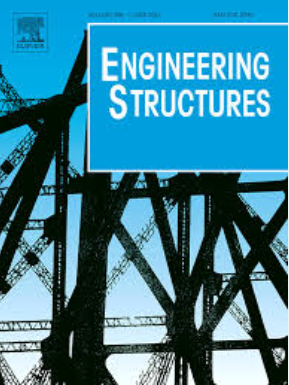盐冻融环境下UHPC-NSC粘结剪切行为及损伤预测模型研究
IF 6.4
1区 工程技术
Q1 ENGINEERING, CIVIL
引用次数: 0
摘要
盐冻融循环后超高性能混凝土-正常强度混凝土(UHPC-NSC)修复界面特性对混凝土修复具有重要意义。研究了S-F-T环境下UHPC-NSC界面的键剪行为。采用单面剪切试验法评价粘结剂抗剪强度。基材抗压强度分别为28 MPa、36 MPa和42 MPa。考虑了种姓表面和高压水处理表面。结果表明:随着基材强度的降低,修复试样的总质量损失增大,这反映了试样表面的侵蚀。S-F-T循环次数为300时,各组体重减轻率均低于1.53 %。S-F-T循环可使氯离子侵蚀面积增加70.1 %以上。S-F-T的作用对UHPC-NSC试件的破坏行为产生不利影响。基材强度越低,界面越光滑,结合强度明显降低。S-F-T循环使UHPC-NSC粘结降低,粘结强度降低42% % ~ 74% %,降低了混凝土修补的耐久性。基材强度越低,界面越光滑,结合强度明显降低。最后,建立UHPC-NSC界面损伤预测模型,估算S-F-T循环对UHPC-NSC界面的损伤程度。该损伤预测模型为混凝土修复耐久性设计提供了依据。本文章由计算机程序翻译,如有差异,请以英文原文为准。
Investigation of bond shear behaviour of UHPC-NSC and damage prediction model under salt freeze-thaw environment
Ultra-high performance concrete-normal strength concrete (UHPC-NSC) repair interface properties after the salt freeze-thaw (S-F-T) cycle have great significance for concrete repair. The bond shear behaviour of the UHPC-NSC interface under the S-F-T environment was investigated. Single-side shear test method was used to evaluate bond shear strength. The substrate with compressive strength of 28 MPa, 36 MPa, and 42 MPa was used. The caste surface and high-pressure water-treated surface were considered. The findings revealed that as the strength of the substrate decreases, the total mass loss of the repair specimens increases, which reflects specimen surface erosion. The weight loss rate of all groups was lower than 1.53 % at the S-F-T cycle number of 300. S-F-T cycles can increase the chloride ion erosion area by more than 70.1 %. The action of S-F-T adversely impacted the failure behaviour of UHPC-NSC specimens. The lower the substrate strength and the smoother the interface, the bond strength reduced significantly. S-F-T cycles degrade the UHPC-NSC bond and decrease bond strength by 42 %-74 %, which decreases the durability of concrete repair. The lower the substrate strength and the smoother the interface, the bond strength reduced significantly. Finally, a UHPC-NSC interface damage prediction model was established to estimate the extent of damage to the UHPC-NSC interface caused by S-F-T cycles. The damage prediction model provides the basis for the durability design of concrete repair.
求助全文
通过发布文献求助,成功后即可免费获取论文全文。
去求助
来源期刊

Engineering Structures
工程技术-工程:土木
CiteScore
10.20
自引率
14.50%
发文量
1385
审稿时长
67 days
期刊介绍:
Engineering Structures provides a forum for a broad blend of scientific and technical papers to reflect the evolving needs of the structural engineering and structural mechanics communities. Particularly welcome are contributions dealing with applications of structural engineering and mechanics principles in all areas of technology. The journal aspires to a broad and integrated coverage of the effects of dynamic loadings and of the modelling techniques whereby the structural response to these loadings may be computed.
The scope of Engineering Structures encompasses, but is not restricted to, the following areas: infrastructure engineering; earthquake engineering; structure-fluid-soil interaction; wind engineering; fire engineering; blast engineering; structural reliability/stability; life assessment/integrity; structural health monitoring; multi-hazard engineering; structural dynamics; optimization; expert systems; experimental modelling; performance-based design; multiscale analysis; value engineering.
Topics of interest include: tall buildings; innovative structures; environmentally responsive structures; bridges; stadiums; commercial and public buildings; transmission towers; television and telecommunication masts; foldable structures; cooling towers; plates and shells; suspension structures; protective structures; smart structures; nuclear reactors; dams; pressure vessels; pipelines; tunnels.
Engineering Structures also publishes review articles, short communications and discussions, book reviews, and a diary on international events related to any aspect of structural engineering.
 求助内容:
求助内容: 应助结果提醒方式:
应助结果提醒方式:


